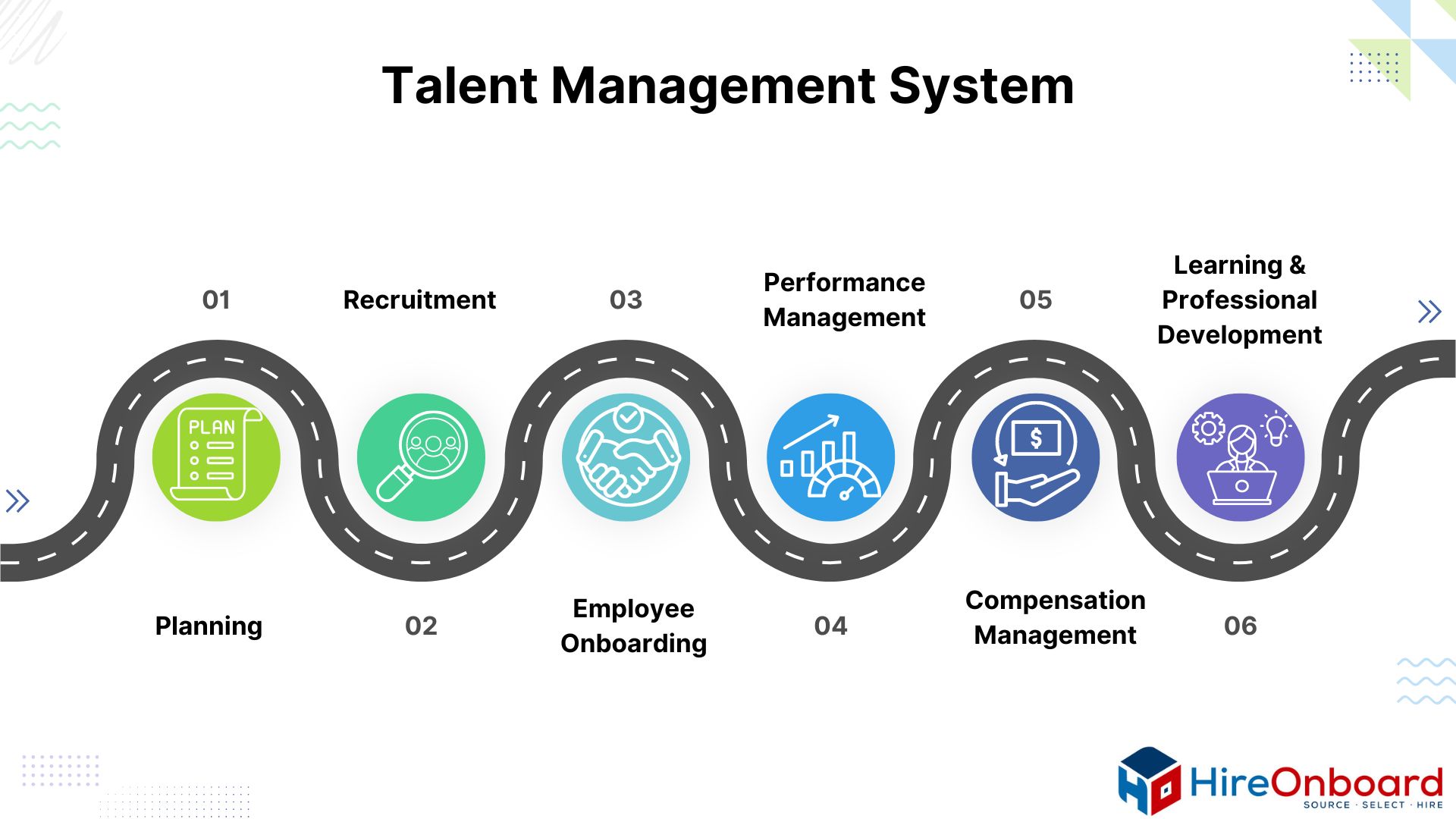What is a Talent management system?
A talent management system (TMS) is an integrated software platform designed to support essential talent management processes, including recruitment, employee onboarding, performance management, learning and professional development, compensation management, and succession planning. These processes, along with the technical capabilities that underpin them, are typically delivered through software modules. This allows businesses to start with the functionalities they require and expand their capabilities as they grow.
Crucially, a TMS enables an organization to align its human resource planning with its business strategy. This alignment ensures that proactive measures are in place to secure the necessary talent to support both current and future business objectives.
Talent management can be defined as the practice of overseeing the entire employee lifecycle, from initial candidate acquisition to succession planning.
How does a talent management system function?
A TMS integrates all the HR modules required to attract, hire, and develop employees. While individual modules—such as recruitment or performance management—are often referred to as talent management systems, standalone modules do not possess the multi-faceted capabilities of a fully integrated system. Such a system supports the complete talent lifecycle and its processes, spanning from initial candidate acquisition to succession planning.
Talent management systems generally operate in the cloud. A cloud platform offers a variety of advantages, including increased data storage capacity, enhanced security measures, and seamless integration with complementary applications like payroll, training programs, career planning, and other systems. Additionally, it ensures the secure storage of employee data, including personal information, demographics, and compensation details.

The following talent management processes are supported:
Plan
Ensure that talent strategies align with the business’s needs. Collaborate with leadership teams to comprehend business objectives, then make certain that the talent strategy supports these goals.
Recruit candidates
Source talent globally, nurture candidates throughout the recruitment process, and utilize the efficiencies of a comprehensive applicant management and tracking system.
Onboard employees
Enhance new hire engagement with a dedicated onboarding portal. Accelerate employee ramp-up through paperless new hire processes. Automate workflows for onboarding, offboarding, and crossboarding.
Manage employee performance
Assist employees in managing their goals. Implement guided action planning for ongoing performance management.
Plan and design compensation models
Reward and recognize high performers.
Develop and retain employees
Provide modern and engaging learning experiences. Schedule and conduct compliance training. Create proactive succession plans and actively cultivate future leaders.
The Evolution of Talent Management Systems
In the 1980s and early 1990s, talent management primarily focused on developing internal talent, which resulted in an overabundance of middle-management roles. During the economic downturn, businesses underwent restructuring, placing greater emphasis on attracting external talent. However, by the late 1990s, organizations discovered they were hiring and losing experienced individuals at roughly the same rate. This realization shifted the focus toward retaining and nurturing existing personnel.
HR processes were integrated, but without a centralized model, each function operated in silos, and information often became outdated. HR professionals and recruiters had to navigate paper-based and time-consuming workflows, leaving little time to concentrate on strategic initiatives.
Comprehensive talent management systems were developed to integrate all HR talent modules within a single platform. This automation and digitization of workflows created efficiencies throughout the organization.
Today, talent management systems are utilized by companies globally and across various industries. A TMS addresses the unique and contemporary challenges related to talent management in the 21st century. For example:
Skilling, upskilling, and reskilling
Identify skills gaps and establish training and reskilling pathways to transition employees to new or evolved roles.
Diversity and inclusion
Implement diversity sourcing and candidate development plans, providing proactive and ongoing development to attract and grow a diverse workforce.
Remote workforces
Adapt employee support mechanisms to accommodate remote workers and introduce new interaction models to optimize manager and employee engagement.
Benefits of Talent Management Solutions
From a business perspective, a talent management system offers a variety of benefits, including:
- An integrated and centralized data model for all talent management activities.
- Recruitment strategies that align with business objectives.
- Enhanced employee onboarding, retention, and development.
- Improved engagement between managers and employees, including streamlined processes for compensation, reviews, and rewards.
Specific User-Based Benefits Include
Recruiters
Efficiently manage the entire recruitment process using career websites, job postings, applications, candidate screening, and employment offers. Applicants can access and explore career websites, apply for roles of interest, and engage through a dedicated candidate portal for interviews and job offers.
Applicants
Easily find job postings on career websites, apply for positions of interest, and engage through a dedicated candidate portal for interviews and job offers.
Human Resources
Seamlessly coordinate all talent management tasks, leveraging powerful data analytics to inform business decisions. Generate detailed reports to share statuses and results, create compensation plans, and easily demonstrate compliance with government and industry regulations.
Managers
Collaborate effectively with recruiters for improved efficiency. Welcome new hires and assist them in ramping up quickly. Manage compensation across entire teams. Utilize streamlined processes to track activities, performance, and ongoing feedback for all assigned employees. Align individual performance goals with business objectives. Implement reward and recognition tools to enhance employee engagement.
Employees
Easily access information and tasks, including goals, rewards, performance reviews, compensation and benefits details, as well as learning paths tailored to individual career aspirations. Recognize peers and redeem rewards and other benefits linked to exceptional performance and results.
Capabilities of a Talent Management System
A talent management system (TMS) enables an organization to execute a comprehensive talent strategy that aligns with its business objectives and goals. For example:
Recruitment
Attract and hire top candidates who can become high-performing employees, enhancing productivity and strengthening the organization.
Development
Cultivate skills and build adaptable teams to drive business performance. Identify and nurture strong leaders for ongoing growth.
Retention
Support employees in their career development, fostering greater engagement and retention.
A TMS also offers operational efficiencies by utilizing a centralized model for planning, data sharing, and other interactions. Digital workflows replace manual and offline processes, increasing backend efficiency and allowing HR personnel to concentrate on higher-value tasks.
The activities associated with a TMS generate personal and confidential data, securely stored in a robust database. Advanced analytics and reporting capabilities aid in strategic planning to ensure that the business meets both its immediate and long-term talent goals.
With a talent management system, companies can effectively plan, measure, and communicate talent outcomes and overall value to the business.


